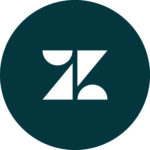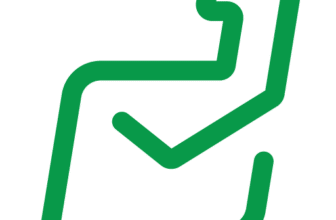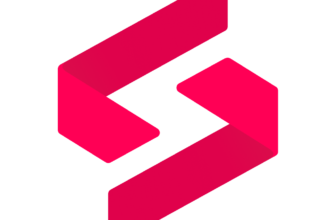Introduction
In the dynamic world of IT Service Management (ITSM), the quest for efficient, scalable, and user-friendly software solutions is ever-present. Among the myriad of options available today, Zendesk stands out as a significant player, offering a suite of tools designed to streamline and enhance IT service delivery. This review aims to delve deeply into the capabilities of Zendesk, providing a thorough analysis of its features and suitability for various organizational needs.
Overview of Zendesk in the ITSM Landscape
Zendesk began as a customer support software company, swiftly evolving to encompass a broader range of service management functions. Today, it’s recognized as a formidable entity in the ITSM market, owing to its robust feature set and adaptability to varying business sizes and types.
The journey of Zendesk, from its humble beginnings to its current prominence, is a testament to its commitment to continuous improvement and customer satisfaction. It’s crucial to understand this trajectory to fully appreciate the capabilities of Zendesk in the ITSM arena.
Zendesk’s standing in the current ITSM market is marked by its ability to offer an integrated approach to service management, encompassing not just technical aspects but also focusing on user experience and service quality. Its reputation is bolstered by endorsements from a wide array of industries, demonstrating its versatility and efficiency in addressing complex IT service challenges.
Objective of the Review
The primary goal of this review is to offer a comprehensive and unbiased evaluation of Zendesk as an ITSM solution. The review will encompass an analysis of core features, user interface, pricing, security standards, and more. To ensure a thorough assessment, we will delve into both the technical aspects of the software and its practical application in real-world scenarios. This review targets a broad audience, ranging from IT managers and service teams, who are directly involved in IT service delivery to business decision-makers seeking to optimize their IT operations.
Software Specification
Core Features of Zendesk
Zendesk, as a robust IT Service Management (ITSM) platform, encompasses a range of core features designed to optimize and streamline IT service processes. Below, we explore six key features that define Zendesk’s capabilities in the ITSM domain:
1. Advanced Ticketing System
Zendesk’s ticketing system is the backbone of its ITSM suite, offering a sophisticated yet user-friendly approach to incident management. This feature allows for the efficient logging, categorization, and tracking of IT issues. Its flexibility accommodates a variety of ticket types, ranging from simple queries to complex technical issues. The system also enables the prioritization of tickets based on urgency and impact, ensuring that critical issues are addressed promptly.
2. Automated Workflow Management
Automation is a standout feature in Zendesk, significantly enhancing operational efficiency. Automated workflows streamline repetitive tasks, such as ticket routing, notifications, and escalations. This feature not only saves valuable time for IT staff but also ensures consistent handling of incidents and requests, leading to improved service levels.
3. Self-Service Options and Knowledge Base
The self-service feature in Zendesk empowers users by providing them with the tools to resolve common issues independently. This includes access to a comprehensive knowledge base, FAQs, and community forums. These resources reduce the volume of incoming tickets, allowing IT staff to focus on more complex tasks while also enhancing user satisfaction through quick and easy problem resolution.
4. Real-Time Reporting and Analytics
Zendesk offers powerful reporting and analytics tools that provide insightful data on IT service performance. These tools allow for the monitoring of key metrics such as ticket volume, resolution times, and customer satisfaction. Real-time analytics offer a deeper understanding of service trends, helping IT managers make data-driven decisions to improve service quality and efficiency.
5. Multi-Channel Support
In today’s diverse technological landscape, Zendesk’s multi-channel support is crucial. It enables IT teams to manage requests and incidents across various channels, including email, chat, social media, and phone. This omnichannel approach ensures a seamless experience for users, regardless of their preferred communication method, and allows for a more integrated and responsive IT service.
6. Customization and Integration Capabilities
Zendesk stands out for its high degree of customization and integration. The platform can be tailored to fit the unique processes and workflows of any organization. It also offers extensive integration options with other business tools and systems, such as CRM software, project management tools, and enterprise resource planning systems. This versatility ensures that Zendesk can function seamlessly within the existing IT ecosystem of an organization, enhancing overall operational coherence.
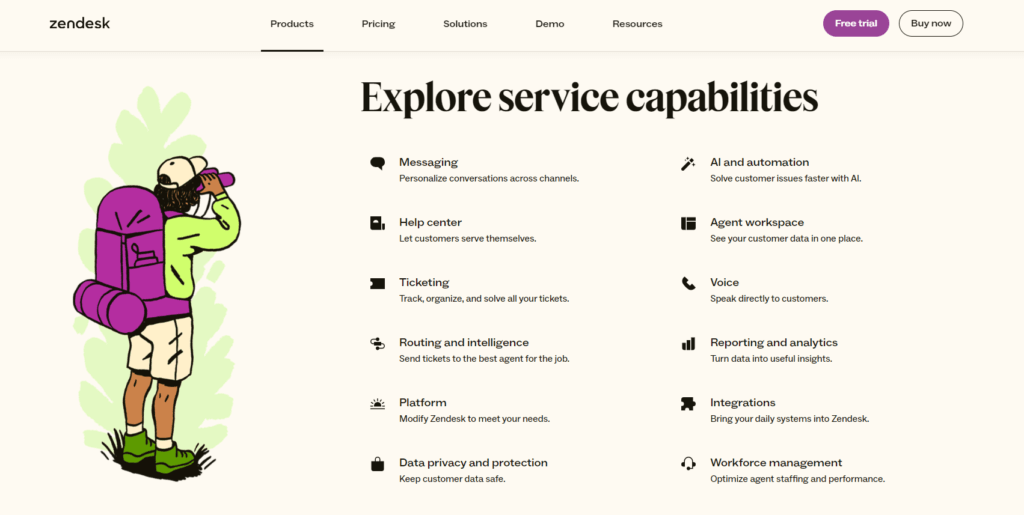
Pros and Cons
Benefits of Using Zendesk
Positive
✅ Comprehensive feature set
✅ Scalability
✅ User-friendly interface
✅ Extensive integration capabilities
Negative
❌ Cost for advanced features
❌ Limited asset management
❌ Complexity for small teams
❌ Dependence on internet connectivity
Pros
- Comprehensive Feature Set
Zendesk offers a robust suite of ITSM tools, including ticketing, automation, analytics, and integrations, making it a one-stop solution for service management. - Scalability
Its pricing plans and customizable features make Zendesk suitable for businesses of all sizes, from startups to large enterprises. - User-Friendly Interface
The intuitive design and navigation ensure a smooth learning curve, making it accessible even to users without technical expertise. - Extensive Integration Capabilities
Zendesk integrates seamlessly with over 1,000 tools, including CRMs, project management software, and productivity platforms, enhancing operational efficiency.
Cons
- Cost for Advanced Features
While feature-rich, Zendesk’s higher-tier plans can be expensive, which may deter small businesses with limited budgets. - Limited Asset Management
Zendesk lacks a dedicated asset management module, requiring users to rely on third-party integrations for this functionality. - Complexity for Small Teams
For smaller teams with simple ITSM needs, Zendesk’s extensive features might feel overwhelming and underutilized. - Dependence on Internet Connectivity
As a cloud-based platform, Zendesk’s performance is heavily reliant on stable internet connectivity, which could be a limitation in certain environments.
Benefits of Using Zendesk
Zendesk, as a comprehensive ITSM solution, brings a multitude of benefits to organizations aiming to optimize their IT service operations. This section highlights the key advantages, including improvements in efficiency and productivity, seamless integrations and compatibility, and the support and community resources available to users.
Efficiency and Productivity Enhancements
Automation of Routine Tasks
One of the most significant benefits of Zendesk is its ability to automate routine tasks. This automation extends beyond mere ticket routing; it encompasses a range of operational processes such as triggering alerts, sending follow-up emails, and updating ticket statuses. By automating these tasks, Zendesk not only reduces the workload on IT staff but also minimizes the chances of human error. This leads to quicker resolution times and more consistent service delivery, contributing to overall productivity enhancement in the IT department.
Collaboration Tools and Their Impact
Collaboration is at the heart of effective IT service management, and Zendesk excels in this area with its range of collaborative tools. These tools facilitate seamless communication and information sharing among IT team members, as well as between IT staff and end-users. Features like shared ticket views, internal notes, and easy escalation procedures ensure that everyone involved is on the same page, enhancing the coordination and speed of issue resolution. This collaborative environment not only boosts productivity but also fosters a more engaged and responsive IT team.
Integrations and Compatibility
Overview of Integrations
The integration capabilities are a key benefit, especially in today’s interconnected business environments. The platform seamlessly integrates with a wide range of systems, including CRM software, project management tools, and even other ITSM solutions. For example, integration with CRM systems allows for a more comprehensive view of customer interactions and issues, while connections with project management tools can facilitate better tracking and alignment of IT tasks with broader organizational goals. These integrations ensure that Zendesk functions not as an isolated tool but as an integral part of the overall IT and business ecosystem.
Compatibility with Existing IT Infrastructure
Compatibility is another crucial aspect of Zendesk’s offering. The platform is designed to work harmoniously with existing IT infrastructures. Its flexibility and scalability mean that it can be adapted to various environments, whether it’s a small business running on a basic IT setup or a large enterprise with a complex, multi-layered infrastructure. This compatibility removes the potential hurdles of extensive system overhauls, making Zendesk an attractive option for a wide range of organizations.
Support and Community Resources
Support Structure
Zendesk’s commitment to user support is evident in its comprehensive support structure. Users can access a variety of support channels, including email, live chat, and phone support, ensuring that help is readily available when needed. Additionally, Zendesk provides a range of online resources such as guides, tutorials, and best practice tips, enabling users to maximize the platform’s potential.
Availability of Community Resources and Forums
Beyond the official support channels, Zendesk boasts a vibrant community of users and experts. The community forums are a rich resource for peer-to-peer advice, troubleshooting tips, and innovative uses. This community aspect not only provides additional layers of support but also fosters a sense of belonging among users, encouraging collaboration and knowledge sharing across different organizations and industries.
In summary, Zendesk’s ITSM solution offers a blend of efficiency-enhancing features, robust integration capabilities, and a strong support framework. These benefits collectively translate into improved productivity, seamless operations, and a supportive environment for IT service management professionals. The next sections of this review will delve into other crucial aspects such as user interface, pricing, security, and compliance standards of Zendesk.
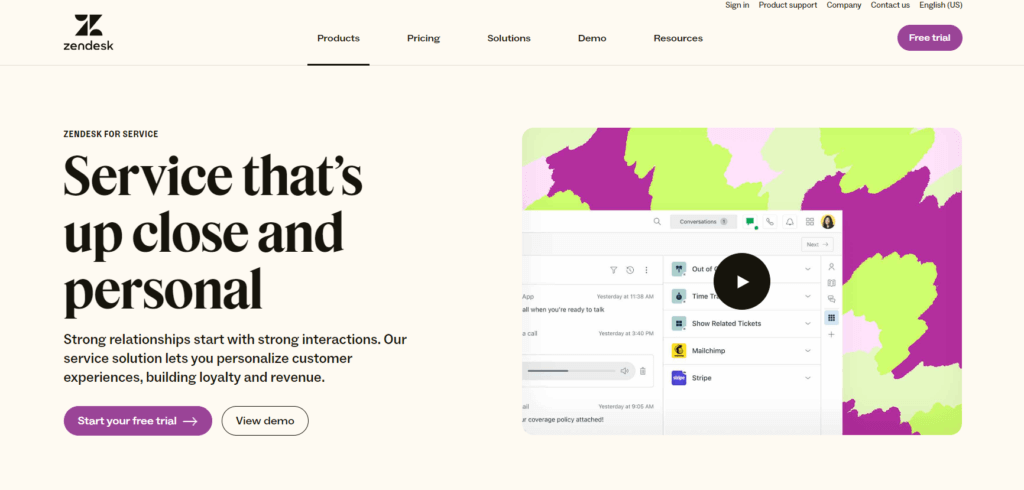
User Experience
User Interface and Operational Simplicity
A crucial aspect of any IT service management software is its user interface and overall user experience. This part of our comprehensive review on Zendesk focuses on these critical components, analyzing how they contribute to the effectiveness and efficiency of the platform.
Ease of Use and Navigation
Visual Design and Layout
Zendesk’s user interface stands out for its clean, intuitive design, making it accessible for users of all technical levels. The visual layout is thoughtfully organized, ensuring that key features and functionalities are easily navigable. This design philosophy extends to the dashboard, where users can get an overview of tickets, performance metrics, and operational insights at a glance. Such a layout not only streamlines the workflow but also reduces the learning curve for new users, allowing them to quickly become proficient in using the system.
Navigation and User Journeys
In terms of navigation, Zendesk provides a fluid user journey. From ticket creation to resolution, every step is streamlined. The interface guides users through a logical progression of tasks, reducing the number of clicks and actions required to perform common operations. This efficient navigation system is particularly beneficial in high-pressure IT environments, where time and ease of access to information are of the essence. Zendesk’s user-focused design ensures that critical information and functions are always just a few clicks away, significantly enhancing overall user productivity and satisfaction.
Mobile Experience and Remote Accessibility
Mobile App Functionality
In today’s mobile-first world, Zendesk’s mobile application is a key component of its offering. The app provides comprehensive functionality, allowing users to manage tickets, communicate with team members, and access service analytics on the go. The mobile interface is optimized for smaller screens, ensuring that the user experience is consistent and effective across all devices. This mobility is particularly valuable for IT professionals who need to manage services remotely or while in the field, offering them the flexibility to stay connected and responsive no matter their location.
Remote Access Capabilities and Limitations
Zendesk’s remote access capabilities are robust, enabling users to access the full suite of ITSM functionalities from any location with internet connectivity. This feature is integral in supporting remote and distributed teams, a common setup in modern workplaces. However, it’s important to note that the effectiveness of remote access can be contingent on network stability and bandwidth availability. While Zendesk is designed to be lightweight and efficient, users in areas with limited internet connectivity might experience reduced performance or limited accessibility to certain features.
Pricing and Plans
How much does Zendesk cost?
Zendesk’s pricing structure is designed to cater to a wide range of businesses, from small teams seeking essential ITSM functionalities to large enterprises requiring a comprehensive suite of service management tools. Below, we detail the different plans offered by Zendesk and discuss which types of organizations might benefit most from each.
Suite Team Plan
Starting at $55 per agent per month, the Suite Team plan is ideal for smaller teams or organizations just embarking on formalizing their ITSM processes. It includes the core ticketing system, access to email, chat, voice, and social messaging channels, and a help center for customer self-service. It also provides standard bots for automation, prebuilt analytics dashboards, over 1,000 apps and integrations, and predefined responses (macros). Additionally, the plan offers custom business rules for triggers and automations, ensuring that even at this level, teams can streamline their workflows effectively. The plan is rounded out with online support from the Zendesk team.
Suite Growth Plan
The Suite Growth plan, at $89 per agent per month, builds upon the Suite Team plan by including more advanced features. This plan is perfect for growing businesses that need more sophisticated ITSM capabilities. In addition to the features of the Team plan, the Growth plan offers multiple ticket forms, allowing for more detailed customer queries, and advanced analytics powered by Zendesk Explore. Companies with an expanding customer base that requires more intricate service management processes will find the Growth plan a worthy investment.
Suite Professional Plan
At $115 per agent per month, the Suite Professional plan is the “most popular,” catering to organizations with more complex ITSM needs. This plan introduces features such as multilingual content in the help center, which is crucial for businesses serving a diverse, global customer base. This plan also includes skills-based routing, ensuring that tickets are directed to the agent best equipped to handle them, enhancing both efficiency and customer satisfaction. Larger businesses with more demanding ITSM requirements or those with specialized service workflows will find the Professional plan particularly valuable.
Suite Enterprise Plan
The Suite Enterprise plan is tailored to meet the needs of large enterprises or organizations with advanced ITSM requirements. Pricing is provided upon request, indicating a highly customized approach to each organization’s unique needs. This plan includes all the features of the other plans, with additions like advanced voice capabilities and the ability to design custom roles and permissions, providing granular control over the ITSM environment. The Enterprise plan also offers priority support, ensuring that any issues are resolved with minimal downtime. Large businesses looking for a comprehensive solution that can be precisely tailored to their ITSM operations will benefit most from the Suite Enterprise plan.
Each of these plans is structured to scale with the growth of your business, ensuring that as your ITSM needs evolve, Zendesk can accommodate them with a suitable plan. For more detailed information on each plan and to determine which might be the best fit for your organization, visit Zendesk Pricing.
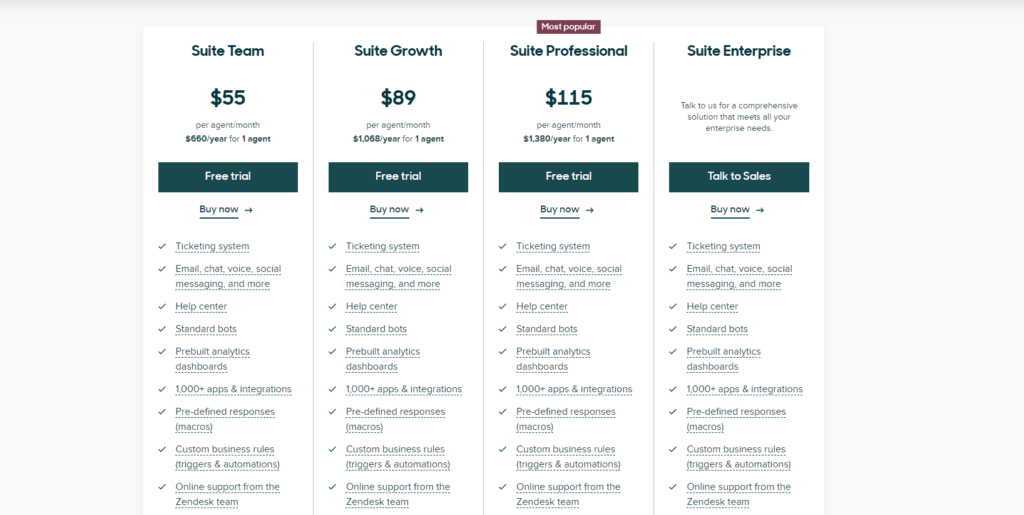
Security and Compliance
Enhanced Security Features in Zendesk
In an era where data breaches are both costly and damaging to a company’s reputation, Zendesk’s commitment to security and compliance is a cornerstone of its ITSM solution. This section explores Zendesk’s approach to protecting sensitive information and ensuring that its users meet regulatory requirements.
Security Features
Data Protection and Encryption
Zendesk understands the criticality of data security and employs robust encryption protocols to safeguard information. All data transmitted to and from Zendesk is encrypted using industry-standard HTTPS over SSL (TLS 1.2), ensuring that sensitive data remains secure in transit. Additionally, at rest, Zendesk databases are protected with encryption, adding an extra layer of security for stored information. This two-pronged approach to encryption ensures that all customer data is thoroughly protected against unauthorized access.
User Access and Permissions
To further strengthen security, Zendesk offers comprehensive user access and permission controls. These controls enable administrators to define and enforce who can access specific types of data and what actions they can perform within the ITSM system. The ability to set granular permissions minimizes the risk of internal data breaches and ensures that users only have access to the information necessary for their role.
Compliance Standards
Adherence to Industry Standards
Zendesk’s platform is built to comply with a range of international regulatory frameworks and industry standards, including the General Data Protection Regulation (GDPR) and the Health Insurance Portability and Accountability Act (HIPAA). This commitment to compliance is crucial for businesses that operate in regulated industries or across national borders. By aligning with such standards, Zendesk not only demonstrates its dedication to privacy and data protection but also helps its users to meet their own compliance obligations.
Audit and Compliance Reporting Capabilities
Zendesk facilitates compliance with audit and reporting capabilities that enable organizations to track and verify their ITSM activities. These tools are designed to provide transparency and accountability, essential for internal audits and regulatory reviews. The platform’s reporting functions allow users to generate detailed logs of service interactions, changes, and access records, which can be critical during compliance assessments.
Conclusion
Final thoughts
Key Takeaways
This review has provided a detailed examination of Zendesk’s ITSM solution, from its robust ticketing system and incident management to its advanced security features and compliance standards. We’ve highlighted Zendesk’s diverse range of pricing plans, each designed to meet the varying needs of different businesses, and discussed the platform’s extensive integrations and compatibility with existing IT infrastructure. Zendesk’s security measures, including data encryption and user access controls, assure users that their data is in safe hands. Moreover, the platform’s adherence to compliance standards like GDPR and HIPAA makes it a reliable choice for organizations concerned with regulatory requirements.
Our Recommendation:
The versatility and scalability of Zendesk’s ITSM solution make it suitable for a wide array of organizations, from small businesses to large enterprises. Each plan is thoughtfully curated to address the specific needs of these diverse user groups. Businesses looking to improve their IT service management processes can consider Zendesk as a viable option, with the understanding that the right plan should align with their operational scale, budget, and long-term IT strategy.
For organizations that prioritize a user-friendly interface, require robust mobile functionality, and value the importance of a supportive community, Zendesk is a compelling choice. Its strong stance on security and compliance further enhances its attractiveness, particularly for those in regulated industries.
Have more questions?
Frequently Asked Questions
Can Zendesk for ITSM be used by organizations without a dedicated IT team?
Absolutely. It is designed to be intuitive and user-friendly, making it suitable for organizations that may not have a specialized IT team. Small businesses or startups can leverage this platform to manage IT services effectively with its automation and self-service features.
Does Zendesk support the ITIL framework?
Yes, it has capabilities that support the Information Technology Infrastructure Library (ITIL) framework, including aspects like incident, problem, change, and release management. This makes it a viable tool for organizations looking to align with ITIL practices.
How customizable are the analytics and reporting features?
Zendesk provides highly customizable analytics and reporting features, allowing users to create and modify dashboards and reports to fit their specific needs. You can track various metrics and KPIs important to your organization and tailor reports to provide the insights that matter most to your team.
Can Zendesk handle asset management for ITSM?
While it doesn’t natively offer a dedicated asset management module, it integrates seamlessly with a variety of third-party asset management tools. This allows users to keep track of their IT assets and manage them within the context of their IT service processes.
Is there an on-premises version of Zendesk available for businesses with strict data residency requirements?
Zendesk is primarily a cloud-based platform, designed to offer flexibility and accessibility. However, for businesses with specific data residency or security requirements, Zendesk can work with partners to find a solution that meets these needs.
What type of training and onboarding does Zendesk provide for new users?
Zendesk offers a comprehensive range of training options, including online tutorials, webinars, and Zendesk’s own training portal with in-depth courses. Additionally, they provide resources for onboarding new users to help them get up to speed with the platform’s features and capabilities.
Can Zendesk’s ITSM solution handle large volumes of tickets?
Yes, Zendesk is built to scale and can handle a large volume of tickets. Its system is designed to maintain performance and responsiveness even under heavy load, ensuring that it can meet the needs of both growing businesses and large enterprises.
Does Zendesk offer any disaster recovery options?
It has robust disaster recovery and data backup processes in place to ensure data integrity and availability. Users can be assured of minimal service disruption and quick recovery in the event of an incident.
How does Zendesk for ITSM support service level agreements (SLAs)?
It allows for the creation and management of SLAs, providing tools to set up and track compliance with specific service expectations. This ensures that IT teams can manage and meet their service commitments effectively.
Are there community-driven innovations or user-generated solutions within Zendesk?
Yes, the user community is a vibrant ecosystem where users share solutions, best practices, and custom scripts. Zendesk also encourages user-driven innovation through apps and integrations, allowing users to extend the platform’s capabilities according to their specific needs.

